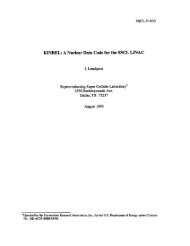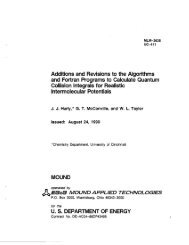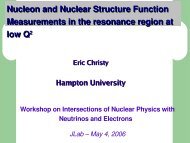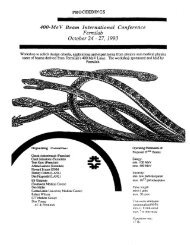Cyril Grignon
Cyril Grignon
Cyril Grignon
You also want an ePaper? Increase the reach of your titles
YUMPU automatically turns print PDFs into web optimized ePapers that Google loves.
Directional detection of non-baryonic<br />
dark matter with MIMAC<br />
<strong>Cyril</strong> <strong>Grignon</strong><br />
LPSC Grenoble<br />
15-20 July 2010, Blois, France
Outline<br />
• Directional detection of Dark Matter<br />
• Discovery potential of directional detection<br />
• The MIMAC prototype<br />
• First experimental results<br />
• Conclusions and outlooks<br />
Blois 2010 <strong>Cyril</strong> <strong>Grignon</strong><br />
2
Directional detection<br />
Why ? we need a robust signature of WIMP detection<br />
The idea: The solar system rotates around the center<br />
of the Galaxy, through a halo of WIMPs, and towards<br />
the Cygnus constellation.<br />
WIMP events should point<br />
towards Cygnus constellation<br />
Cygnus Constellation (l = 90 ,b = 0 )<br />
Incoming WIMP flux in a detector<br />
placed on earth<br />
Blois 2010 <strong>Cyril</strong> <strong>Grignon</strong><br />
Cygnus<br />
Direct detection: interaction of the WIMP<br />
with a nuclei of the detector, measurement<br />
of the recoil energy<br />
WIMP<br />
nuclei<br />
(E,L, Θ, φ)<br />
Directional detection: Direct detection + 3D<br />
reconstruction of the recoil nuclei<br />
3
What if we<br />
measure this ?<br />
Interest of directional detection<br />
Directional signal Isotropic background<br />
WIMP mass of 100 GeV.c -2<br />
100 WIMP + 100 Background events<br />
10 Kg CF 4 during 5 months<br />
1.5x10 -3 pb SD WIMP cross-section<br />
5 < Er < 50 keV and 15° angular resolution<br />
Vs<br />
Blois 2010 <strong>Cyril</strong> <strong>Grignon</strong><br />
Need a dedicated strategy to<br />
extract information<br />
4
Discovery potential of directional detection<br />
b [degrees]<br />
B: background S: theorical WIMP signal<br />
‐<br />
l [degrees]<br />
Blois 2010 <strong>Cyril</strong> <strong>Grignon</strong><br />
Likelihood analysis with a blind<br />
analysis (m χ, l, b, N WIMP free):<br />
• Signal from Cygnus detected<br />
with the correct (l,b) value<br />
• N WIMP = 106 +-15 (68 % CL)<br />
• Constraint on σ<br />
M: Measurement<br />
5
10 kg CF 4<br />
5 months<br />
3 σ discovery<br />
region<br />
J. Billard et al. ,<br />
arXiv:0911.4086<br />
Discovery<br />
100 WIMP + 100 Bkg<br />
J. Billard et al.,<br />
arXiv:1006.3513<br />
It’s a very promising strategy<br />
Blois 2010 <strong>Cyril</strong> <strong>Grignon</strong><br />
Exclusion<br />
0 WIMP + 300 Bkg<br />
10 kg CF 4<br />
3 years<br />
6
Which detector to achieve such performance<br />
nuclei<br />
Noyau<br />
cible<br />
• Low pressure gaseous TPC => mm tracks<br />
• Low energy threshold and measurement of the quenching factor<br />
• High spatial resolution<br />
(E,L, Θ, φ)<br />
• Dedicated self-triggered electronics<br />
• Dedicated analysis => 3D track<br />
• Electron/recoil discrimination<br />
Blois 2010 <strong>Cyril</strong> <strong>Grignon</strong><br />
Below 50 keV<br />
nuclear recoil<br />
7
cathode<br />
micromesh<br />
anode<br />
Gaz: 3 He + 5% isobutane<br />
128 μm<br />
WIMP<br />
WIMP<br />
The MIMAC project<br />
Strategy:<br />
matrix of gaseous micro-TPC<br />
direct detection of nuclei recoil<br />
low mass target : sensitive to light WIMPs ( < 10 GeV)<br />
Axial interaction<br />
15 cm<br />
e -<br />
3 He<br />
strip readout<br />
Charge sensitive<br />
preamplifier<br />
µTPC<br />
E = 200 V/cm<br />
E = 30 kV/cm<br />
n<br />
Low pressure gaseous detector, 3 He,<br />
CH 4, C 4H 10, CF 4 : few mm tracks<br />
low energy recoil :10 keV<br />
Background rejections based on:<br />
energy and track : e-/nuclei<br />
correlation of µTPC (neutrons)<br />
direction<br />
Have to precisely measure recoil Energy and<br />
to reconstruct the 3D track of the nuclei for directionality<br />
Blois 2010 <strong>Cyril</strong> <strong>Grignon</strong><br />
8
First key point : the quenching<br />
factor for energy measurement<br />
Q Measured for gaseous mixtures<br />
(He + C 4H 10) at low energy: Dark<br />
Matter range covered<br />
MIMAC first prototype<br />
Pixelized micromegas<br />
(300 µm pixels) : 9 cm 2<br />
(CEA Saclay)<br />
Q =<br />
µTPC<br />
I. Giomataris et al.,<br />
NIM. A 560 (2006)<br />
E<br />
E<br />
Second key point : the 3D track reconstruction<br />
Blois 2010 <strong>Cyril</strong> <strong>Grignon</strong><br />
ionization<br />
recoil<br />
D. Santos et al. 2008,<br />
arXiv:0810.1137<br />
E measured : 400 eV !<br />
(σ/Ε) : 34%<br />
15 cm<br />
9
3D reconstruction strategy<br />
Complete electronic system<br />
(ASIC+FPGA+DAQ)<br />
ASIC: 16 strips channels<br />
with mixer & shaper (energy)<br />
FPGA: On-board processing<br />
Each 25 ns scan of the (x,y) anode<br />
Blois 2010 <strong>Cyril</strong> <strong>Grignon</strong><br />
t=50 ns<br />
t=0 ns<br />
t=25 ns<br />
Number of images * Drift velocity<br />
+ 2D projection<br />
3D Track reconstruction:<br />
L, θ and φ<br />
10
MIMAC ASIC and DAQ designed at LPSC<br />
Mixer & shaper Energy<br />
16 channels:<br />
Charge sensitive preamplifiers<br />
+<br />
Current comparators<br />
+<br />
5 bit DACs<br />
Six ASIC for each side<br />
Total of 192 channels<br />
O. Bourrion et al,<br />
arxiv:1006.1335<br />
Self-triggered electronic for Anode<br />
sampling @ 40 MHz<br />
3250µm x 4700µm<br />
[area ~ 15 mm 2 ]<br />
J.P. Richer et al, arxiv 0912.0186<br />
X, Y and central FPGA<br />
The 3 FPGA process,<br />
concentrate and time<br />
sort data for each side<br />
First version running, second version under test (8 ASIC, total of 512 channels)<br />
Blois 2010 <strong>Cyril</strong> <strong>Grignon</strong><br />
Serializer (Position)<br />
11
Expected angular resolution<br />
SRIM (nuclei interactions) + Magboltz (electron diffusion) + detector simulation (DAQ ...)<br />
He + 5% iC 4H 10<br />
350 mbar<br />
C. <strong>Grignon</strong> et al, 2010<br />
Blois 2010 <strong>Cyril</strong> <strong>Grignon</strong><br />
σ =18° @ 10 keV<br />
Promising for<br />
directional<br />
detection<br />
Need a real measurement !<br />
12
3D Track : 5.9 keV electron from 55 Fe<br />
XY<br />
XZ<br />
YZ<br />
3D reconstruction<br />
He + 5% iC 4H 10<br />
350 mbar<br />
Blois 2010 <strong>Cyril</strong> <strong>Grignon</strong><br />
Typical background<br />
in DM detection !!<br />
13
XY<br />
XZ<br />
YZ<br />
Alpha track from 222 Rn<br />
He + 5% iC 4H 10<br />
350 mbar<br />
Blois 2010 <strong>Cyril</strong> <strong>Grignon</strong><br />
3D reconstruction<br />
3D works for high energy<br />
nuclei, what about the<br />
keV scale ?<br />
14
Neutron field: Amande facility @ Cadarache<br />
Proton or<br />
deuton beam<br />
Target:<br />
Sc for 8.2 keV n<br />
LiOH for 144 keV n<br />
neutron field<br />
prototype with<br />
pixellized bulk<br />
micromegas<br />
Simple to use: Mono-energetic neutrons => induce WIMP-like signal<br />
Blois 2010 <strong>Cyril</strong> <strong>Grignon</strong><br />
15
XY<br />
XZ<br />
YZ<br />
Proton recoil in He + Iso<br />
3D reconstruction<br />
8 keV proton recoil, 2.4 mm<br />
He + 5% iC 4H 10<br />
350 mbar<br />
Blois 2010 <strong>Cyril</strong> <strong>Grignon</strong><br />
Typical signal in<br />
DM detection<br />
Preliminary<br />
16
XY<br />
XZ<br />
YZ<br />
Fluorine recoil<br />
Ionization energy : 50 keV (with quenching) , 3 mm<br />
70 % CF 4 + 30% CHF 3<br />
55 mbar<br />
Blois 2010 <strong>Cyril</strong> <strong>Grignon</strong><br />
3D reconstruction<br />
Preliminary !!<br />
Promising for discovery<br />
within a realistic time frame<br />
with a 10 kg detector<br />
17
He + 5% iC 4H 10<br />
350 mbar<br />
Protons / electrons discrimination<br />
electrons<br />
recoils<br />
Separate gamma background from WIMPs<br />
Key point for DM detector !!!!<br />
Blois 2010 <strong>Cyril</strong> <strong>Grignon</strong><br />
Preliminary results<br />
144 keV<br />
18
Conclusions and outlooks<br />
Directional detection is a promising search strategy to discover galactic dark matter<br />
The MIMAC detector provides both energy of the recoil and the 3D track<br />
Firsts 3D tracks reconstructed with the prototype:<br />
5.9 keV electrons (typical background)<br />
low energy proton AND fluorine recoils (typical signal)<br />
Recoils/electrons discrimination possible with the first prototype<br />
Next steps:<br />
2011: 4 liter detector placed in an underground tunnel<br />
2013: Larger detector (1 m 3 ) will be built within an international collaboration<br />
Long term : dark matter astronomy, cosmology with nuclear recoils<br />
Blois 2010 <strong>Cyril</strong> <strong>Grignon</strong><br />
19
The MIMAC collaboration<br />
LPSC (Grenoble) :<br />
J. Billard, C. <strong>Grignon</strong>, F. Mayet, D. Santos<br />
Technical Coordination : O. Guillaudin<br />
- Electronics : G. Bosson, J-P. Richer<br />
- Gas detector : A. Pellisier<br />
- Data Acquisition: O. Bourrion<br />
- Mechanical Structure : Ch. Fourel<br />
- Ion source : T. Lamy, P. Sole<br />
CEA-IRFU (Saclay) : P. Colas, E. Ferrer, I. Giomataris<br />
IRSN (Cadarache): C. Golabek, L. Lebreton<br />
Blois 2010 <strong>Cyril</strong> <strong>Grignon</strong><br />
20
















